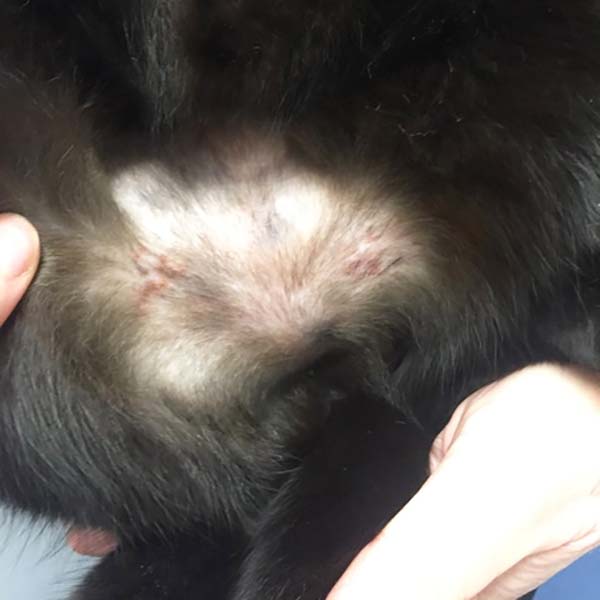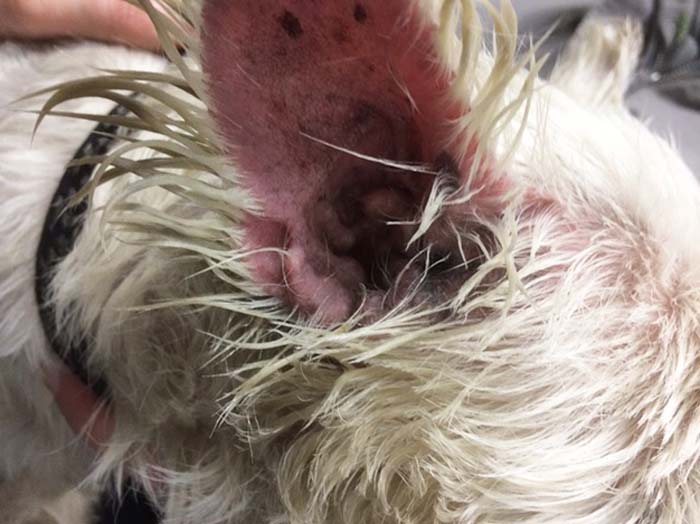10 Aug 2020
Animal allergy clinics: getting to the bottom of irritants
John Redbond discusses the value of such clinics, how to identify and treat allergic skin disease, and key messages to share with dog and cat owners.

Allergic skin disease is one of the most common skin conditions seen in practice (Paterson, 2010); it is varied in form, difficult to diagnose and tricky to manage.
Pruritus (itchiness) is shown to affect 30% to 40% of all canine and 19% of feline cases seen in practice, with allergy accounting for 10% of canine patients presenting with dermatological signs and the majority of pruritic cats (Hill et al, 2006; Hobi et al, 2011).
Such a large number of difficult cases presenting to the practice requires a considered and targeted approach to diagnoses and case management, with a specific allergy clinic being a great way to provide the cases with the time and energy they require.
Clinic purpose
As we will see, the approach to the diagnostic steps is critical to firstly correctly identifying allergy over other causes of skin disease, then secondly to ascertaining the type of allergy. But this isn’t the only factor a clinic such as this is good for.
Use of an allergy clinic allows a practice to:
- gather a comprehensive dermatological history – vital to diagnosis
- perform the tests needed to rule out other causes of skin disease
- facilitate the appropriate use of tests to identify sensitivities once allergy has been identified
- discuss any treatments prescribed to increase owner compliance
- spend time with the owner discussing allergies for him or her to fully appreciate the various considerations related to this lifelong disease
- support owners long-term, increasing the chances of treatment success and reducing the likelihood of the owner becoming frustrated by the disease
Make use of veterinary nurses
Allergy clinics require time and patience, as well as expertise and experience. An RVN who has been given training in this area is more than qualified and ideal to facilitate the use of these clinics, without needing to sacrifice any first opinion veterinary consultations to run them.
Ascertain cause of allergy
The initial task of the allergy clinic will be to ascertain firstly whether the symptoms are indeed an allergic response and then what the cause of the allergy is. The three main causes of an allergic response in dogs and cats are:
- fleas, known as flea allergic dermatitis (FAD)
- something in food, knows as cutaneous adverse food reaction (CAFR)
- something in the environment, known generally as atopic dermatitis (AD)
Fleas
Fleas remain the most common cause of pruritus in dogs and cats (Paterson, 2010), so must never be overlooked; patients in the first instance may be pruritic because of an infestation without an allergic response, but the clinical approach is the same with regards to diagnosis and treatment.
Allergic patients (FAD) react to the saliva injected by the flea when it feeds and, as such, can have a very low, almost undetectable level of fleas on the coat – particularly in the case of cats – making it harder to diagnose than may be imagined; or, indeed, to persuade the owner of this being the cause – a tricky task when many owners are sensitive to the notion of their pets and house harbouring fleas.
Diagnosis is made by a combination of clinical signs, the detection of flea faeces on the coat and the assessment to response to flea treatment. Serology tests are available to detect sensitivity – these alone are not sufficient to rule this in or out, but can be useful to persuade our stubborn owners.

Food
To simply say a patient is allergic to something in food is to oversimplify the possible causes of this response, and a lack of clarity about this still exists within the field. For this reason, this is referred to instead as CAFR, as mentioned.
However, what does make things a little more straightforward is the approach to the case is the same regardless – both for diagnosis and eventual treatment if diagnosed, with the use of a food trial to eliminate this as a cause of the allergic reaction.
Perhaps not so straightforward is actually successfully performing a food trial on the patient, which requires the identification first of a food that either contains novel protein and carbohydrate sources for the specific patient or the use of a hydrolysed diet; then the completely exclusive feeding of this diet for, in the opinion of most texts, around eight weeks.
This requires incredible compliance and discipline from the owner, so is impossible to fully advocate in a standard consultation – an allergy clinic gives you the opportunity to discuss this and support the owners through the process.

Environment
AD is a genetically predisposed inflammatory and pruritic allergic skin disease with characteristic features associated with IgE antibodies to environmental allergens (Halliwell, 2006), and is a significant cause of pruritus: some reports suggesting, for example, as much as 15% of dogs have AD.
What makes AD tricky to diagnose is it requires a diagnosis of exclusion, with the clinician needing to rule out other causes of pruritus; non-allergic (such as parasites) and allergic (FAD and CAFR as aforementioned). This involves a thorough history – preferably with a questionnaire – before the performing of superficial skin tests and, ideally, a food trial.
AD has a presentation similar to other allergic diseases – especially CAFR – which is why it is important to rule these out of the differential; it is also often compounded by secondary infections involving bacteria and/or yeast, which need to be managed as well for the patient’s comfort and to aid diagnosis of the underlying cause.
Serology is available to ascertain allergic cause; however, as positive tests can be found in asymptomatic patients and, in some cases, more than one issue can be contributing to a presenting skin problem, this is only really useful to ascertain cause for desensitising vaccines.
All of this means an allergy clinic is not only helpful, but essential in helping to facilitate the diagnosis of this disease both in terms of performing the process of gathering history and performing tests, but also in supporting and walking the owners through this process.
Key messages for owners
One of the real benefits of an allergy clinic is the time available with clients.
Firstly, to discuss this disease and the variations of it with the owner, allowing time to talk this over in more detail. As we have seen, a methodical approach is needed to correctly ascertain the cause of a skin problem first as an allergic response, before then the specific cause of this response.
Talking the owner through this process, and the methods and tests used to eliminate other causes and factors, is vital to their cooperation with a lengthy and often costly process, and a lack of client compliance can frustrate the diagnostic process (Forsythe, 2014).
Next, the process itself takes time as well – the gathering of history is essential as a diagnosis is based on the findings of a constellation of typical history and clinical signs (De Bellis, 2014). Great benefit exists to going through the questionnaire with an owner, and the clinic allows for this, as well as time for a clinical examination and performance of superficial tests – such as tape strips, impression smears, ear cytology and skin scrapes – which make up a complete diagnostic work-up.
Once a diagnosis has been reached, usually a multimodal approach to treatment is most successful (Neuber, 2018), with our allergy clinic allowing for a considered and supported approach with the owner.
Looking briefly at the treatment for the different allergic responses:
FAD treatment
Treatment for FAD is achieved by limiting flea bites to a small enough level that FAD is not triggered (Griffin, 2012). So, the allergy clinic, much like an everyday VN clinic, works in this scenario to educate and support the owner thorough flea control; informing on the flea cycle and various environmental considerations alongside the management of an allergic response where other therapy may also be needed.
CAFR treatment
Once a diagnosis has been made, CAFR is best controlled with the simple avoidance of the offending food (Colombo, 2020). If symptoms have been resolved by the use of a low allergy or hydrolysed food during the diagnostic process, a true diagnosis is made by challenging the patient with food sources to identify the allergen – this can then make it easier to control the reaction long-term.
However, in many cases an owner will be determined once symptoms have improved to remain on the existing diet long-term – sometimes with accompanying antipruritic medication and topical management alongside.
However this is managed, the allergy clinic allows for discussion with owners, considerations as to their options and long-term support through a lifelong disease.
Atopy treatment
Unlike CAFR, avoiding the allergen when it is environmental is very difficult to achieve and, therefore, unlikely to be successful (Neuber, 2018). Without doubt the first priority of the person delivering the allergy clinic is to educate the owner as to the lifelong nature of the disease, informing him or her of the need for some form of therapy for the rest of the patient’s life.
Once an owner appreciates this, while also understanding that this is a manageable disease in the majority of cases, he or she is more likely to be compliant and make full use of the clinic to his or her pet’s benefit.
Approaching the condition with a prevention mindset, rather than waiting for the condition to “flare”, is the best management and often achieved with a very multimodal approach to the many treatment options:
- Topical therapy has the benefit of being non‑systemic and achievable in most cases at home, without revisits for prescriptions. Shampoo therapy removes allergens and overgrowth of microbial flora, while also moisturising and restoring the skin barrier function needed to protect the patient from the allergen it is sensitive to. Ear cleaners are also important to prevent flares starting in the ear – a common site for symptoms to begin.
- Anti-inflammatory and antipruritic therapies – for example, oclacitinib, ciclosporin, lokivetmab, antihistamines and glucocorticoids – are available and often used for long‑term management or when cases flare.
- Allergen-specific immunotherapy is the closest to a cure, by reducing the immune response to the allergen. This helps reduce the background response, which leads to the flares in the first place and so reducing their instances. However, a need still exists to manage any flares with anti-inflammatory or antipruritic medication, as well as the surface of the skin with topical therapy, hence the importance of educating the owner to the multimodal approach to therapy.
With all of the types of allergy, it is important to help the owner understand the pruritic or itch threshold. His or her companion has a sensitivity that, even when managed, can be aggravated by other factors; often these factors once added to the existing dormant, underlying sensitivity can push the pet past the threshold where it begins to scratch.
Once this has happened, the condition soon cascades down with the addition of skin inflammation and microbial flora; this is our “flare”. Understanding this process from the outset can go a long way to helping the owner manage the condition long-term.

Conclusion
An allergy clinic is not just a useful tool in the approach and management of cases with allergic skin disease, but essential to their successful management. Any vet or nurse will need education and support in establishing this clinic – as such, it is a fantastic opportunity to make full use of the veterinary nurse’s qualification and skill with owner support, to set up and deliver the clinic to the benefit of vet, owner and practice – but most of all the patient.
